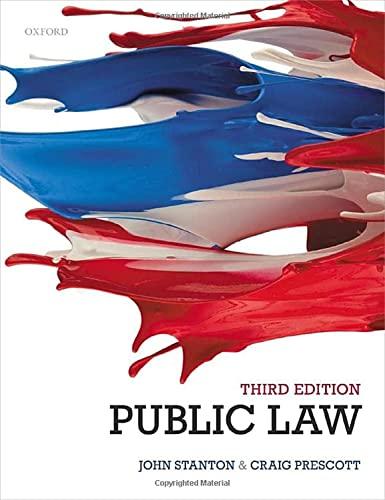Question
Please respond to the 1 and 2 student's posts weather or not you think their opinion is correct, please simply share your thoughts 1. I
Please respond to the 1 and 2 student's posts weather or not you think their opinion is correct, please simply share your thoughts
1. I agree with the majority opinion in the Garret case. Justice Stevens wrote the majority opinion, which affirmed that the school district must pay for the services provided to Garret during the school day. Stevens explained that the Individuals with Disabilities Education Act (IDEA) is designated to "to assure that all children with disabilities have available to them . . . a free appropriate public education which emphasizes special education and related services designed to meet their unique needs" (p. 68). The district argued that they did not have the funds to provide Garret with the services required, but Stevens refuted that point by arguing that the "related services" language was significant because it was interpreted differently from "medical services." The majority believed that in the Garret case, a medical professional was not needed to meet Garret's needs, thus it was not considered a "medical service," but rather a "related service" that the school district must pay for. Stevens expanded upon this point writing, "Whatever its imperfections, a rule that limits the medical services exemption to physician services is unquestionably a reasonable and generally workable interpretation of the statute" (p. 76). Aside from the financial implications that this may have for the district, the IDEA law clearly stated that Garret should have access to a "free appropriate public education."
The differences in the statutory laws helped me further understand Garret's outcome, but it did not change my perspective on how the case should have been provided. As it pertained to funding, the Disability Rights Education and Defense Fund indicated that IDEA "provides federal funds under Parts B and C to assist states and local education agencies in meeting IDEA requirements to serve infants, toddlers and youth with disabilities." This was relevant in the Garret case as the district argued that funding was an issue, but the law directs federal funding to states to aid the localities in meeting the education requirements. It was interesting to see the differences in which jurisdictions had the responsibility to meet the requirements set forth in the ADA, IDEA and Section 504. The IDEA law was also relevant in the Garret case as the law was designed to provide for a free, appropriate public education by designing "instruction at no cost to the parents, to meet the unique needs of the child with a disability..." (Disability Rights Education and Defense Fund). The ADA was applicable in this case as the public school is providing a "public service" and the ADA "prohibits discrimination solely on the basis of disability in employment, public services, and accommodations" (Disability Rights Education and Defense Fund). Section 504 was also applicable because the statute detailed students must receive an "appropriate" education that was comparable to education provided to students without disabilities (Disability Rights Education and Defense Fund). It appeared that all the statutory laws can be applied in the Garret case, but the IDEA law seemed the most pertinent as Garret met the qualifications under the law and that IDEA provided federal funding to states and localities to meet the requirements, which countered the district's argument.
2. I agree with the holding that the clause "related services" encompasses nursing services, such as the type that Garret requires, on the grounds that "continuous services may be more costly and may require additional school personnel, but they are not thereby more 'medical'" (76). Additionally, since Iowa is a recipient of federal funds under the IDEA for this precise purpose, I find the District's fiscal argument to be weak. Albeit I do not fully understand how the grant amounts are determined for each participating state under the IDEA, I assume they could request more financial support at the next opportunity to renew the contract if the demand and costs have increased.
The dissent's argument makes compelling points, which I contemplated heavily. Most prominently, that the "Department of Education regulations require districts to provide disabled children with health-related services that school nurses can perform as part of their normal duties" (85). Operating Garret's ventilator would require a dedicated staff person that the district would have to hire or reassign an existing school nurse; either option would mean that "normal duties" would be altered. However, this argument is not relevant to the question before the court of whether operating a ventilator falls under the medical services exclusion provision.
Reviewing the DREDF comparison affirms my stance. IDEA requires that "related services are provided if students, require them in order to benefit from specially designed instruction" (DREDF(Links to an external site.)). As the majority concludes, "it is undisputed that the services at issue must be provided if Garret is to remain in school"(79). I think this ruling would also be supported under the ADA and Section 504 as well on the grounds that they both protect any individual who may have "a physical or mental impairment that substantially limits one or more life activities." Garret cannot breathe (a life activity) without his ventilator, therefore reasonable accommodations, such as providing nursing services, must be made so that he can attend school.
Step by Step Solution
There are 3 Steps involved in it
Step: 1

Get Instant Access to Expert-Tailored Solutions
See step-by-step solutions with expert insights and AI powered tools for academic success
Step: 2

Step: 3

Ace Your Homework with AI
Get the answers you need in no time with our AI-driven, step-by-step assistance
Get Started


